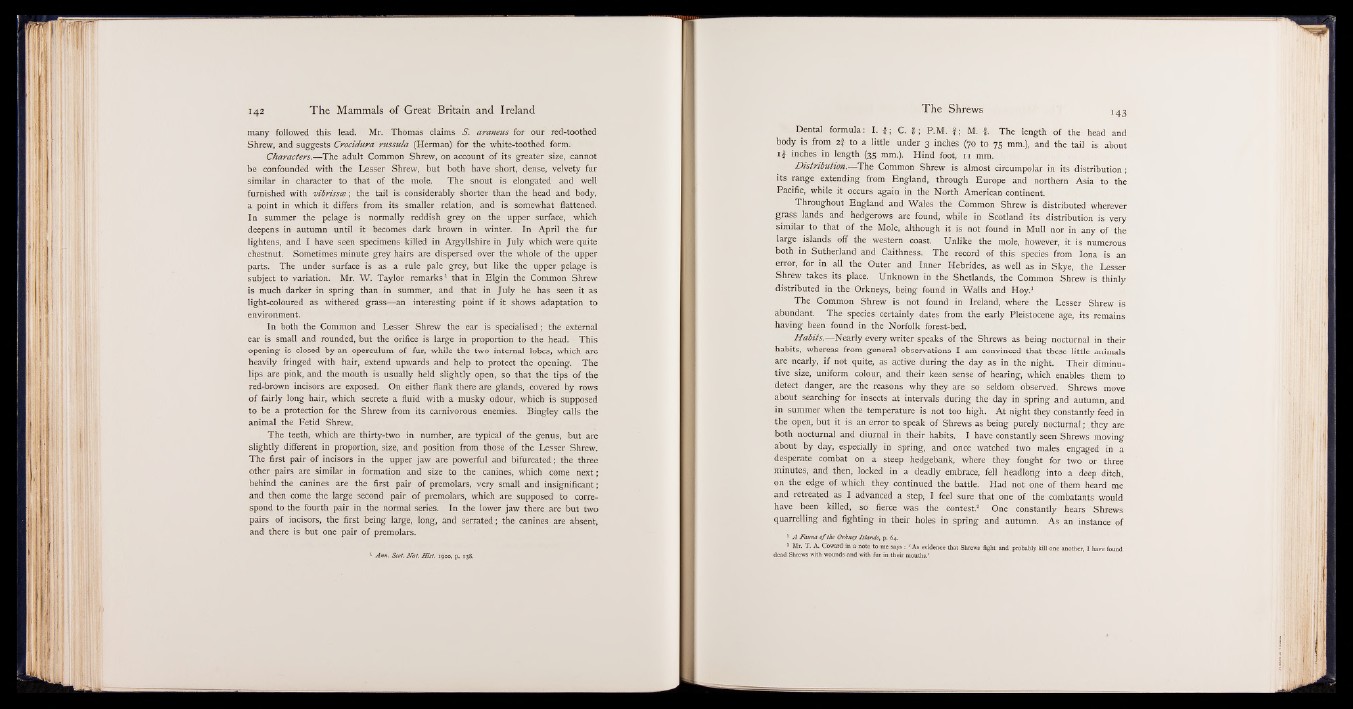
many followed this lead. Mr. Thomas claims S'. araneus for our red-toothed
Shrew, and suggests Crocidura russula (Herman) for the white-toothed form.
Characters.— The adult Common Shrew, on account of its greater size, cannot
be confounded with the Lesser Shrew, but both have short, dense, velvety fur
similar in character to that of the mole. The snout is elongated and well
furnished with vibrissa; the tail is considerably shorter than the head and body,
a point in which it differs from its smaller relation, and is somewhat flattened.
In summer the pelage is normally reddish grey on the upper surface, which
deepens in autumn until it becomes dark brown in winter. In April the fur
lightens, and I have seen specimens killed in Argyllshire in July which were quite
chestnut. Sometimes minute grey hairs are dispersed over the whole of the upper
parts. The under surface is as a rule pale grey, but like the upper pelage is
subject to variation. Mr. W. Taylor remarks1 that in Elgin the Common Shrew
is much darker in spring than in summer, and that in July he has seen it as
light-coloured as withered grass— an interesting point if it shows adaptation to
environment.
In both the Common and Lesser Shrew the ear is specialised; the external
ear is small and rounded, but the orifice is large in proportion to the head. This
opening is closed by an operculum of fur, while the two internal lobes, which are
heavily fringed with hair, extend upwards and help to protect the opening. The
lips are pink, and the mouth is usually held slightly open, so that the tips of the
red-brown incisors are exposed. On either flank there are glands, covered by rows
of fairly long hair, which secrete a fluid with a musky odour, which is supposed
to be a protection for the Shrew from its carnivorous enemies. Bingley calls the
animal the Fetid Shrew.
The teeth, which are thirty-two in number, are typical of the genus, but are
slightly different in proportion, size, and position from those of the Lesser Shrew.
The first pair of incisors in the upper jaw are powerful and bifurcated; the three
other pairs are similar in formation and size to the canines, which come next;
behind the canines are the first pair of premolars, very small and insignificant;
and then come the large second pair of premolars, which are supposed to correspond
to the fourth pair in the normal series. In the lower jaw there are but two
pairs of incisors, the first being large, long, and serrated; the canines are absent,
and there is but one pair of premolars.
Ann. Scot. Nat. Hist. 1900, p. 138.
Dental formula: I. f ; C. P.M. f ; M. I The length of the head and
body is from 2f to a little under 3 inches (70 to 75 mm.), and the tail is about
inches in length (35 mm.). Hind foot, 11 mm.
Distribution.— The Common Shrew is almost circumpolar in its distribution;
its range extending from England, through Europe and northern Asia to the
Pacific, while it occurs again in the North American continent.
Throughout England and Wales the Common Shrew is distributed wherever
grass lands and hedgerows are found, while in Scotland its distribution is very
similar to that of the Mole, although it is not found in Mull nor in any of the
large islands off the western coast. Unlike the mole, however, it is numerous
both in Sutherland and Caithness. The record of this species from Iona is an
error, for in all the Outer and Inner Hebrides, as well as in Skye, the Lesser
Shrew takes its place. Unknown in the Shetlands, the Common Shrew is thinly
distributed in the Orkneys, being found in Walls and Hoy.1
The Common Shrew is not found in Ireland, where the Lesser Shrew is
abundant. The species certainly dates from the early Pleistocene age, its remains
having been found in the Norfolk forest-bed.
Habits.— Nearly every writer speaks of the Shrews as being nocturnal in their
habits, whereas from general observations I am convinced that these little animals
are nearly, if not quite, as active during the day as in the night. Their diminutive
size, uniform colour, and their keen sense of hearing, which enables them to
detect danger, are the reasons why they are so seldom observed. Shrews move
about searching for insects at intervals during the day in spring and autumn, and
in summer when the temperature is not too high. At night they constantly feed in
the open, but it is an error to speak of Shrews as being purely nocturnal; they are
both nocturnal and diurnal in their habits. I have constantly seen Shrews moving
about by day, especially in spring, and once watched two males engaged in a
desperate combat on a steep hedgebank, where they fought for two or three
minutes, and then, locked in a deadly embrace, fell headlong into a deep ditch,
on the edge of which they continued the battle. Had not one of them heard me
and retreated as I advanced a step, I feel sure that one of the combatants would
have been killed, so fierce was the contest.2 One constantly hears Shrews
quarrelling and fighting in their holes in spring and autumn. As an instance of
1 A Fauna o f the Orkney Islands, p. 64.
* Mr. T. A. Coward in a note to me says : ‘As evidence that Shrews fight and probably kill one another, I have found
dead Shrews with wounds and with fur in their mouths ’